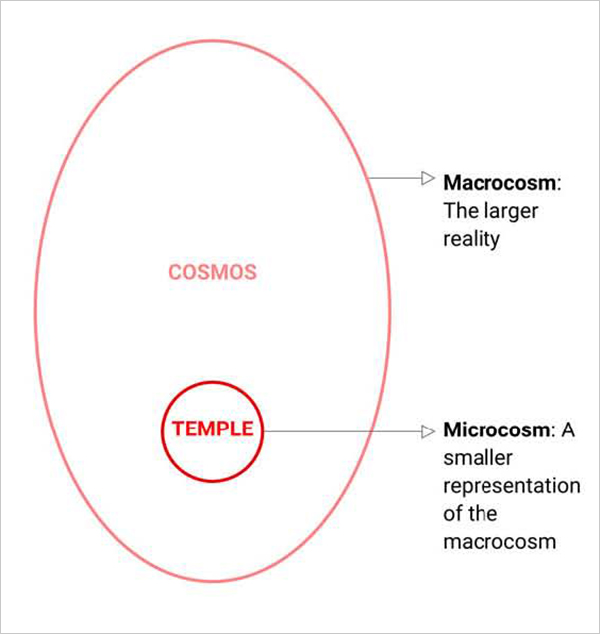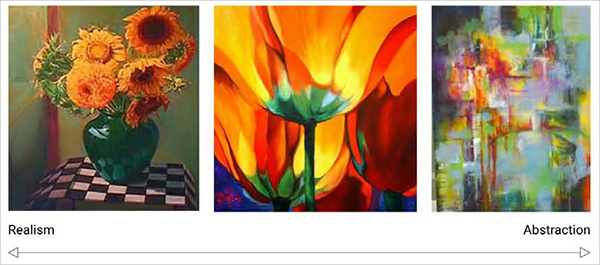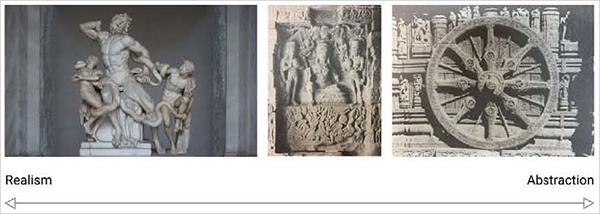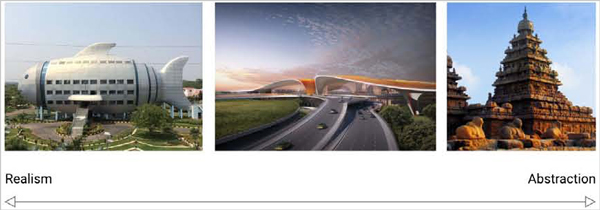Having an Abstract idea ’Cosmic Order’, ’Cosmic Process’, ’Cyclicity’, ’Continuity’, ’Time’, ’Abundance’, ’Wisdom’, ’Grace’- are some of the common themes which have been visualised. In some cultures, the concepts of Cosmic Order have been realised as a relationship between the microcosm of man (Purusa) to the macrocosm of the universe (Purusa). This microcosm is created here on Earth and is suggestive of the larger macrocosm (see Figure 49). Almost all religious places of worship, like temples, mosques and churches, aim to be such microcosms.
An abstract idea arises from a set of strong principles and beliefs, which need not be religious. Its principles are well understood by the artist/designer, and it exists in his mind as a Formless mental image. Although abstraction above a certain level might seem too vague and unrequired to an uninitiated outsider, it (a) helps giving a concrete direction to the design process which would otherwise be lost considering the diverse cultural and geographical backgrounds of artists all around India, and (b) it gives every design a “story”, making the design itself more valuable, interesting and timeless.

Abstract v/s Real
The real world around us has what’s called Form- it is a direct representation of what it is. A direct representation of the world around us is called a realism. Some examples of realism can be seen in visual arts, such as Greek sculptures and realist paintings. Realism attempts to represent the subject matter truthfully without any artistic embellishments and implausible elements.
Abstraction, on the other hand, is a representation of ideas, the formless, the abstract, in such a way that it doesn’t directly depict any person, place or thing. The artist impersonalises the subjective, and the content then becomes an abstract emotion, rather than a representation of actuality. Abstraction takes liberties of not having to conform to any particular shape or colour. Total abstraction bears no trace to any recognisable reference. Abstraction allows the imagination to run wild and gives one a chance to escape from reality. It doesn’t have any objective meaning, and its meaning depends on the perception of the experiencer. Some examples of abstraction in arts and architecture, depending on the level of abstraction, can be temples and other places of worship (high abstraction), abstract paintings (varying levels of abstraction), sculptures (low to medium level of abstraction depending on the representation), and so on.

Figure 50: Abstract v/s Real representation in art
Figure 50 shows an example of abstraction in art. The leftmost image is the most realistic representation of a vase of flowers. As one starts abstracting it, only the essence remains. As the level of abstraction increases, we arrive at a product that barely represents the actual original flower vase.

Figure 51: Abstract v/s Real sculptures
Figure 51 shows three levels of abstraction in ancient sculptures. The first one shows a realist Greek sculpture which is a representation of three human figures. The second shows a Mahalakshmi Figure from Elura Caves. There is slight abstraction as the human figures are still discernible, but there is use of techniques like metaphors and symbolism. The third sculpture of a spoked wheel shows a high level of abstraction. Also called the Dharmachakra, it is a widespread symbol found in many Buddhist and Hindu arts, and holds multiple meanings.

Figure 52: Abstract v/s Real architecture
Figure 52 shows abstraction using examples from architecture. The leftmost building is a famous fisheries office in Hyderabad, India, and is represented using the form of a fish. The middle one is the Beijing Airport by ZahaHadid Architects. The roof of the airport is folded in such a way as to resemble the wings of a bird. It holds the essence and communicates it visually, but doesn’t literally depict a bird. The third image is that of a Hindu temple, which is a highly abstract representation of the cosmos on earth using multi-layered metaphors.
Symbolism and Storytelling
When the artist has an abstract idea, it is important to effectively communicate it to the audience, so that they can fully understand the product/art in its depth. In Ancient India, this communication was done with the help of storytelling and symbolism. An intriguing story is of paramount importance because it captures and captivates the audience, making them take even more interest in the design. In ancient India, countless number of stories emerged across the vast geographical landscape. Although different from each other in their own way, many of these stories shared common themes and characters which people could relate to. It also helped provide the artists with a common design grammar, even though they were separated by thousands of kilometers.
One such story that led to the creation of almost all temples throughout India was that of the origin of the Cosmos, which began with the Primordial Man, the Purusa, the Supreme Being, whose body parts became different parts and elements of the Universe, like Earth, Fire, Water and so on. The centre of the Universe formed from the navel of the Purusa. This story was slightly moulded to suit different cultures throughout the sub-continent, but the basic premise remained the same. That is the reason we see a common binding theme across all temples, although their detailing and form might differ. This story of Cosmic origin did not just influence temples and other architecture, it also greatly influenced other classical arts like Dance and Sculpture. A story acts like a binding theme, both for the artist and the experiencer, making the whole experience richer and deeper. It gives every element some meaning, some role to play in the grand scheme of things, and connects it to other elements effectively.

